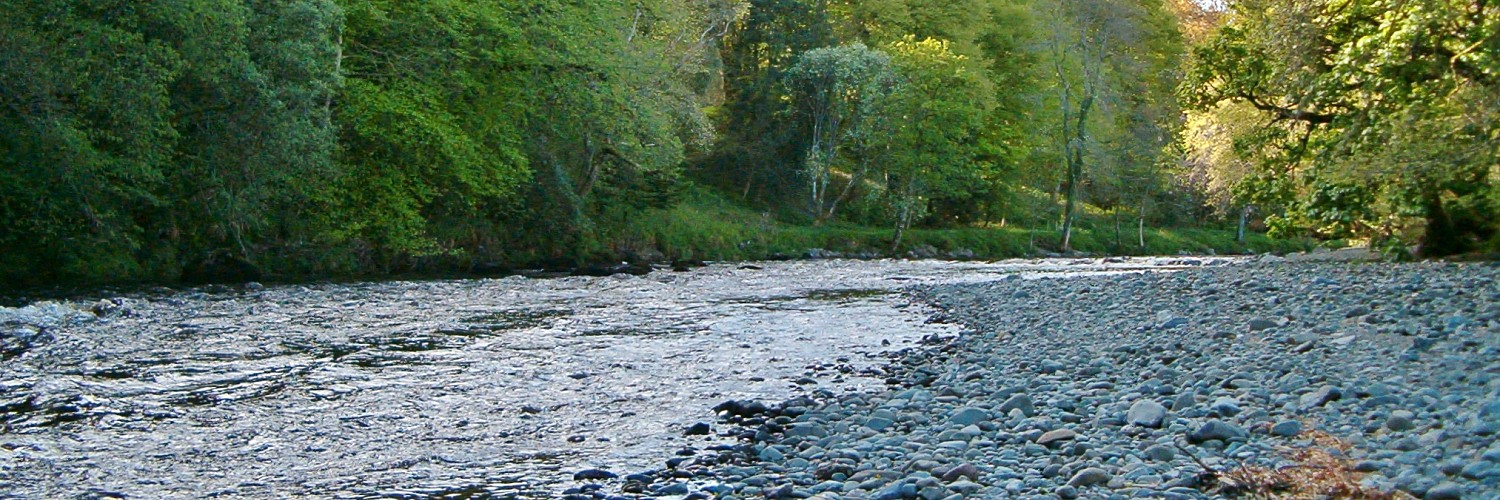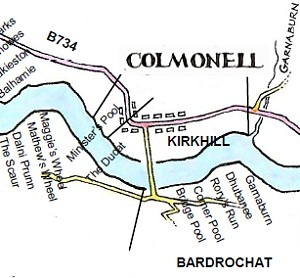The Board has implemented a number of conservation initiatives in order to improve fish breeding conditions in the river system:
- Hatchery
- Smolt Trap implementation
- Habitat surveying
- Electro fishing surveys
- Temperature Data loggers
- LIFE Salmon Project
Habitat Quality
A detailed habitat survey was completed to full industry standard in 2003, which will help ensure that restoration projects provide maximum benefit to the fish and other wildlife in the River Stinchar system.
The survey clearly shows that main impacts on river habitat quality in the Stinchar are commercial coniferous plantations, intensive livestock farming and riverbed excavation. Forestry has resulted in acidification in the headwaters, and more rapid water run off due to an increased number of drainage channels.
Although the Stinchar has always been a spate river due to the steep nature of its catchment, flash floods are increasingly common. These have degraded instream and riparian habitat, and transported large amounts of potential spawning gravel downstream.
Several areas of the upper Stinchar, River Duisk and smaller tributaries have been affected by livestock grazing, which has resulted in extensive bank erosion and siltation. This has reduced spawning gravel quality, and instream cover for fry and parr. The Ayrshire Rivers Trust (ART) has produced a detailed analysis of areas which require bank side fencing and tree planting, and is currently working with landowners and farming groups such as FWAG to help the District Salmon Fishery Board improve the worst affected areas.
Compared with other Ayrshire rivers, there are few large point sources of pollution on the Stinchar. However, potential hazards created by farming include sheep dip pens near burns, farm drains and silage pits. Much of the lower Stinchar valley has been dominated by dairy farming including improved pasture for grazing and silage production. In many places improved bank side fencing would help protect the river from agricultural pollution.
The lower Stinchar contains no serious obstructions to fish movement, although some fairly large rock weirs have been created for angling purposes. Obstructions on the Duisk include bridge aprons in poor condition, collapsed farm gates and waterfalls. There are waterfalls in the upper reaches of most tributaries on the Stinchar and many steep sections which run down through gorges. The Stinchar Falls, for instance, appear to be impassable upstream. Stocking into some of these inaccessible areas has been carried out in recent years to try and boost production, and this is likely to continue on an annual basis.
River Stinchar Habitat Enhancement Project
Following the completion of a catchment wide electrofishing survey in 1990 and a bank side habitat survey in 1994 by WGFT the River Stinchar Habitat Enhancement Project (RSHEP) was initiated by the River Stinchar District Salmon Fishery Board (RSDSFB) in affiliation with the West Galloway Fishery Trust (WGFT). This project is financed jointly by the RSDSFB, Whitley Animal Protection Trust, Enterprise Ayrshire and the Lendal Environmental Trust.
Electrofishing surveys have been undertaken since the summer of 1999. This information is essential to understand clearly the health, distribution and densities of the River Stinchar salmonid stocks, to monitor the enhancement measures completed and to direct future works to the correct areas.
Redd Washout In The River Stinchar
Studies in spate rivers in North West Scotland and North America have shown that egg loss during winter spate floods can be a major bottleneck for salmonid productivity. Gravel movement in the River Stinchar is a major concern, and may be becoming more serious as spate flows have increased.
This is thought to be due to the wetter climate and land use changes in the catchment, particularly the increase in improved grassland and forestry areas and corresponding loss of rough pasture and moorland.
To assess whether redd washout is a problem in the Stinchar, and to begin quantifying the extent of any effect, the Trust initiated a project in winter 2002.
Bone beads were used to simulate salmon and trout eggs, as they are a similar density and size. The beads were threaded onto nylon line, attached to metal stakes and buried in artificial redds. The beads were buried at 15cm for trout, and 30cm for salmon, to simulate natural redd building depths. The artificial redds were then left in the river until spring when salmonid eggs in the river had hatched.
The survey results showed that a proportion of the beads were still buried, and some were washed out. In several cases artificial redds could not be found, it is thought that this is likely to be due to accumulation of gravel above the stakes, but this could not be conclusively proven.
It was seen that redd washout affected both salmon and trout redds, although the trout redds were washed out far more frequently. This is unsurprising, given that these eggs were buried at a much shallower depth. However, given that the vast majority of trout spawning takes place in smaller streams, trout eggs are likely to be better protected against spate flows than these results suggest.
Overall, more than one third of the salmon redds were washed out, indicating that scouring is an important loss of salmon eggs in parts of the catchment, although this figure is considerably lower than many rivers examined in the north of Scotland. Most of the intact redds were found in the upper reaches of the river, suggesting that flows in the upper reaches are not strong enough to destroy redds and that salmon in this part of the river are more likely to hatch successfully. It is also notable that the redds next to gravel traps previously constructed by the Galloway Fisheries Trust were both intact at the end of the survey, suggesting that these habitat improvements may have helped stabilise spawning gravel and directly improved production of juvenile salmon.
The majority of areas where redds were washed out were considered to be likely problems areas prior to the survey taking place, due to the presence of large unstable gravel bars and bank erosion (e.g. Minuntion and the Water of Assel), or high proportions of bedrock (Water of Gregg). Most problem areas should therefore be identified in the habitat survey currently being carried out on the Stinchar, which will help to prioritise future efforts to stabilise the river bed.


